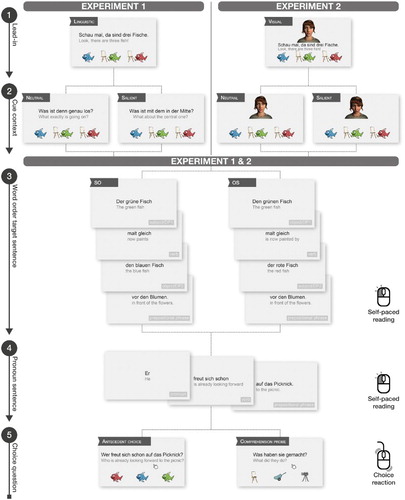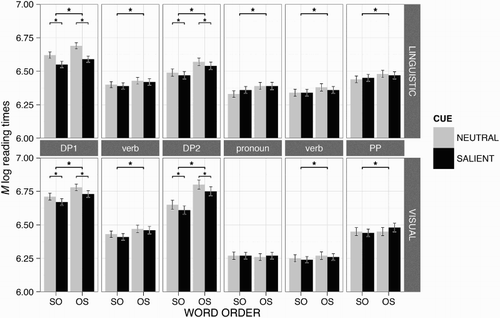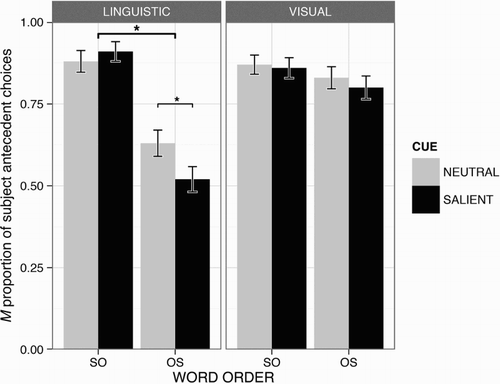Figures & data
Figure 1. Experimental design of Exp. 1 (linguistic Modality) and 2 (visual Modality) with approximate English translation written in grey. First, participants read the lead-in sentence (1). Subsequently, the salient or neutral Cue context (2) was presented followed by the SO or OS Word order target sentence (3). In the salient cue condition, the SO or OS sentence mentioned the salient referent (i.e., green fish) first (i.e., as DP1). Afterwards, the pronoun sentence (4) was presented. In the choice question phase (5), either an antecedent choice question or a comprehension probe had to be answered.
Abbreviations: SO = subject-verb-object, OS = object-verb-subject, DP = determiner phrase.

Table 1. Linear mixed effects model output for log reading times across sentence positions of the word order sentence.
Table 2. Linear mixed effects model output for log reading times across sentence positions of the pronoun sentence.
Table 3. Logit mixed effects model output for subject antecedent choices.
Figure 2. Mean (M) log reading times across relevant sentence positions during processing the word order sentence (DP1, verb, DP2) and the pronoun sentence (pronoun, verb, PP) for the linguistic (Exp. 1: upper panel) and visual Modality (Exp. 2: lower panel). Statistically significant effects with |t| > 1.96 are marked with an asterisk. Error bars indicate 95% confidence intervals (CIs). For the within-subject factors (Cue, Word order) the CIs exclude the between-participant variance (Cousineau, Citation2005) and were corrected according to Morey (Citation2008).
Note: Significant effects of Modality are not indicated in the figure but are only discussed in the main text (see section 3.1). Abbreviations: SO = subject-verb-object, OS = object-verb-subject, DP = determiner phrase, PP = prepositional phrase.

Figure 3. Mean (M) proportion of subject antecedent choices for the pronoun “He” for the linguistic (Exp. 1: left panel) and visual Modality (Exp. 2: right panel). Statistically significant effects with |z| > 1.96 are marked with an asterisk. Error bars indicate 95% confidence intervals (CIs). For the within-subject factors (Cue, Word order) the CIs exclude the between-participant variance (Cousineau, Citation2005) and were corrected according to Morey (Citation2008).
Abbreviations: SO = subject-verb-object, OS = object-verb-subject.

